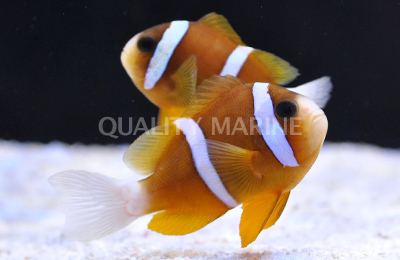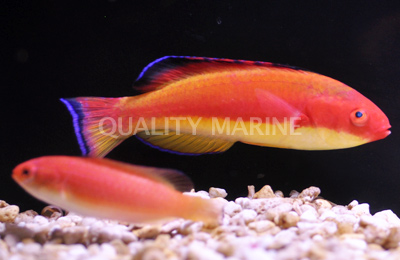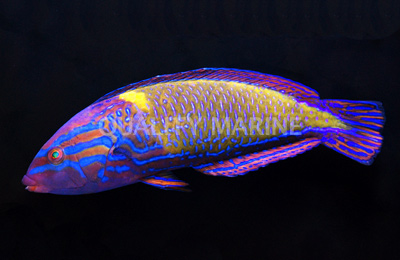New Caledonias Unique Fishes

New Caledonias Unique Fishes
At the end of the Cretaceous, some 65 million years ago, the landmass we that we know today as New Caledonia was still firmly attached to Australia. Over the next 15 million years, it began to slowly drift further east until it arrived near to its current location, roughly equidistant between New Zealand, Fiji, and its old home along Eastern Australia.
Today, the terrestrial fauna of New Caledonia is in many ways like a time capsule, preserving lineages which largely went extinct elsewhere. But this hasnt been the case with its marine fauna. For the most part, the coral reef fishes in this region are the same ones we might find in the West Pacific or across the islands of Oceania. However, for a few groups, we can observe faint hints of endemism. This hasn't been well-studied, but through some confluence of the prevailing ocean currents and underlying topography a number of interesting fishes have developed in these South Pacific reefs. Lets examine a few...
Sunrise Anthias (Pseudanthias sp.)
Quality Marine shook up the aquarium world in 2013 when it began exporting from New Caledonia a previously unknown species of mesophotic anthias. This stunning fish occurs in large shoals down at depths that push the limits of diving technology, and, to this day, it still has not been found anywhere else. The name Sunrise Anthias was given, in reference to the bright yellow forebody and the series of orange bars that line the back, but the species remains scientifically undescribed. Its closest relatives are undoubtedly Loris Anthias (P. lori) and the Red Saddled Anthias (P. flavoguttatus), but there are plenty of differences which allow this Caledonian beauty to be told apart. In all likelihood, this species will be found elsewhere in the deeper reefs of the Pacific, though it is a bit surprising that this hasnt already happened, as neighboring countries have all been explored quite extensively at this point. Where is this fish hiding, or is it truly an endemic species here?


Akindynos Clownfish (Amphiprion cf akindynos)
The true Akindynos Clownfish is a russet brown fish from subtropical reefs of Australia possessing a thin, broken stripe on its head. This fish is, in turn, closely related to McCullochs Clownfish, known only from the reefs around Lord Howe Island and Norfolk Island. And when we move further east into New Caledonia, we encounter a third fish, which may or may not represent a distinct species. The Caledonian population of A. akindynos is similar in color to the Australian population, but typically has darker pelvic and anal fins (dark brown versus orange-brown). Additionally, the head stripe is more variable, often being unbroken at the apex, though not always. Given the tendency of Amphiprion to produce endemic species, this geographically distinct fish is likely to be unique to this island (as well as some of the southern parts of nearby Vanuatu); however, you arent likely to find this one in aquarium exports presently. Fishes identified as A. akindynos are generally collected near the tropical reefs of Cairns, Australia in the northern section of the Great Barrier Reef, and these differ in several subtle ways from the true subtropical representativesits true identity is somewhat controversial.

Conspicuous Angelfish (Chaetodontoplus conspicillatus)
The Conspic is among the most iconic of reef fishesthe top shelf of pomacanthids, with a price tag to match. Its appeal comes as much from its beauty as it does from its extreme rarity within the aquarium trade. Populations exist in just a few scattered subtropical reefs in the South Pacific. At Lord Howe and Norfolk Islands, this fish is unable to be collected due to governmental restrictions, thus all wild-collected specimens originate from New Caledonia. Here, it is an uncommon sight in moderately deep reefs, generally observed singly or in pairs. In the past year, aquaculturists have succeeded in breeding this holy grail, raising the possibility that it may someday become available to a wider segment of the aquarium keeping hobby.

Hooded Flame Wrasse (Cirrhilabrus bathyphilus)
Cirrhilabrus is a genus especially prone to developing highly restricted species, and New Caledonia has a few to choose from, though none are truly endemic here. The Southwest Pacific is home to a beautiful lineage of reddish, deepwater fairy wrasses comprised of C. nahackyi (Fiji, Tonga), C. efatensis (Vanuatu), and C. bathyphilus (Australia, New Caledonia). The true Hooded species is actually the recently described Vanuatuan population, while those shared between Australia and New Caledonia possess a more widespread and diffuse red coloration. Meanwhile, in an entirely different group, there is an even more restricted species found here, one which is also currently undescribed. It has been collected at both Vanuatu and New Caledonia and has been given the trade name Vila Fairy Wrasse (after the town of Port Vila in Vanuatu). It is a close relative of C. punctatus, but can be told apart by the ochrous line that runs along the back. Lastly, the inimitable Laboutes Fairy Wrasse (C. laboutei) is another South Pacific native, with a distribution that rings the Coral Sea. Morphologically spekaing, this species is utterly unique with Cirrhilabrus, making it an especially interesting choice for a Caledonian biotope.

Femininus Wrasse (Anampses femininus)
Species that might be considered rare to aquarists are oftentimes quite abundant in the wild. Perceived rarity for some fishes stems simply from the challenges in bringing them to market, and few fishes embody this better than the gorgeous blue and yellow fish known as the Femininus Wrasse. Unlike the other species discussed thus far, A. femininus is quite widespread, occurring from subtropical Australia in the west all the way to Easter Island in the east. And within this range it abounds in large shoals, generally being found in quite shallow waters. So why is this considered such a rare fish? For starters, it is only found on truly subtropical reefs, which naturally limits which countries are able to export it (primarily Australia, New Caledonia and Vanuatu). And this species is challenging to ship, requiring considerable space to swim during the long flight to LA, which considerably adds to its expense. When you factor in how beautiful this Anampses is in both the female and male sex, its no wonder that this fish boasts one of the highest costs out there. But for those looking to create a New Caledonian themed aquarium, this is certainly a must-have.
